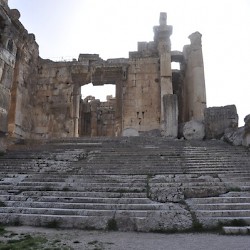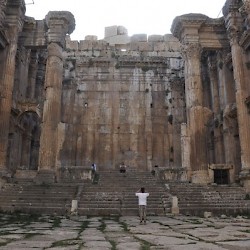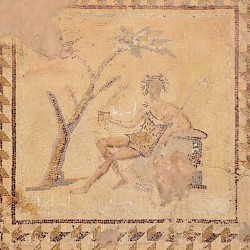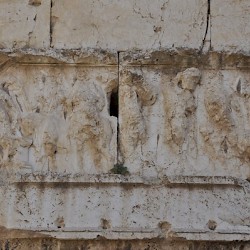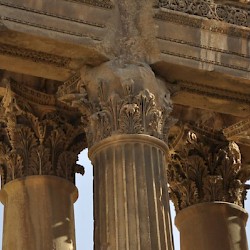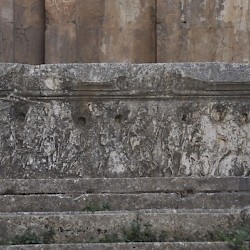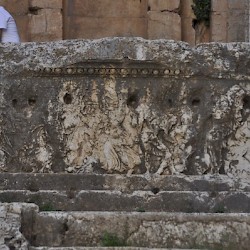Baalbek, Temple of Bacchus
Q1991217Baalbek or Heliopolis (Greek: Ἡλιούπολις, "sun city"): town in the northern Bekaa valley, site of the largest sanctuary in the Roman world.
Temple of Bacchus
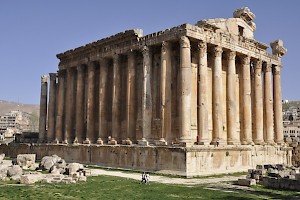
Although it is sometimes called "the small temple", it is larger (and better preserved) than the Parthenon in Athens. (The sanctuary in Baalbek is 36 meters wide and 69 meters long, while the temple in Athens measures 31 x 69 meters.) Being eight columns wide and fifteen columns deep, the Lebanese temple is one of the largest of Antiquity, but still, it is dwarfed by the temple of Jupiter next to it.
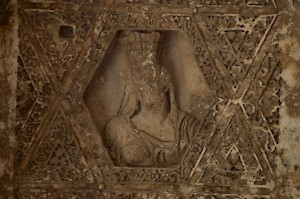
The smaller sanctuary is also called the "temple of Bacchus", but in fact we do not know for certain whether it was dedicated to the god of wine and ecstasy at all. There is a pretty strong indication, however, because there are representations of the story of the youth of the god of wine and ecstasy. Besides, we know that this ecstatic cult was quite popular in the ancient Near East. The Phoenicians venerated Shadrapa, a god similar to Bacchus and Dionysus.
Because this temple was part of Baalbek's Medieval fortifications (a square tower in the southeast still occupies a part of the stairs leading to the temple, while there are barracks visible in the southwest), it is well preserved. The main entrance is decorated with grapes and vines and is an impressive eleven meters high. It is flanked by two smaller gates leading to rooms on a second floor. Other examples of this arrangement can be seen in the Great Temple of Niha, in Sfiré, and in the temple of Artemis in Gerasa.
The cult room itself is surrounded by columns that are engaged to the wall; between them, there are two levels of statue niches. Like the Great Temple of Niha, the room is divided into a lower part and a higher part in the rear, accessible through stairs. The damaged parapets are decorated with dancing Maenads, an indication that this is indeed a temple of Bacchus. Below this higher part is a crypt, where the cultic vessels may have been kept. Again, the closest parallel is the Great Temple of Niha.
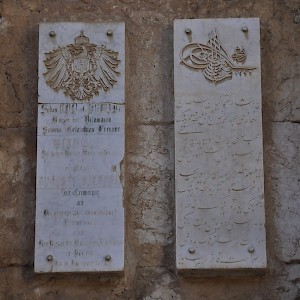
The lavish baroque decoration of the temple of Bacchus is extremely fine and can be dated to the second century CE, which is why it is usually assumed that it was completed during the reign of the emperor Antoninus Pius (r.138-161). If you walk through the northern corridor between the outer wall of the temple and the columns, you can see on the ceiling the representations of several crowned ladies, who represent the cities that financed the construction of this temple. On the lintel over the entrance is a fine eagle (symbol of Jupiter), holding a herald's staff (symbol of Mercury), between two cupids (symbol of Venus).
Finally, an interesting detail from a more recent past. On one of the walls, you can easily recognize the double inscriptions of the German emperor Wilhelm II, who had visited the sanctuary in 1898, and his Turkish colleague, sultan Abdulhamid II. Similar memories of the imperial tour of the Ottoman Empire can be seen in Constantinople (the German Fountain), Damascus (tomb of Saladin), and Jerusalem (Jaffa Gate).
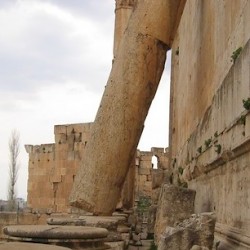 Baalbek, Temple of Bacchus, Exterior, Column |
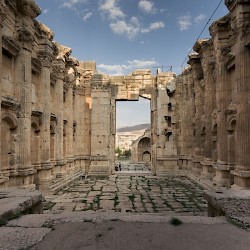 Baalbek, Temple of Bacchus, View from cella |
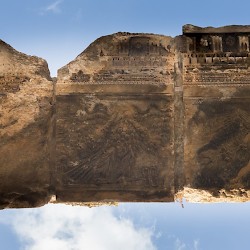 Baalbek, Temple of Bacchus, Lintel |
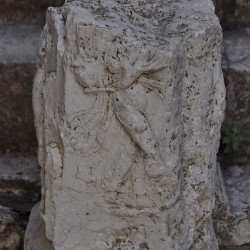 Baalbek, Temple of Bacchus, Decoration of the stairs to the cella |
